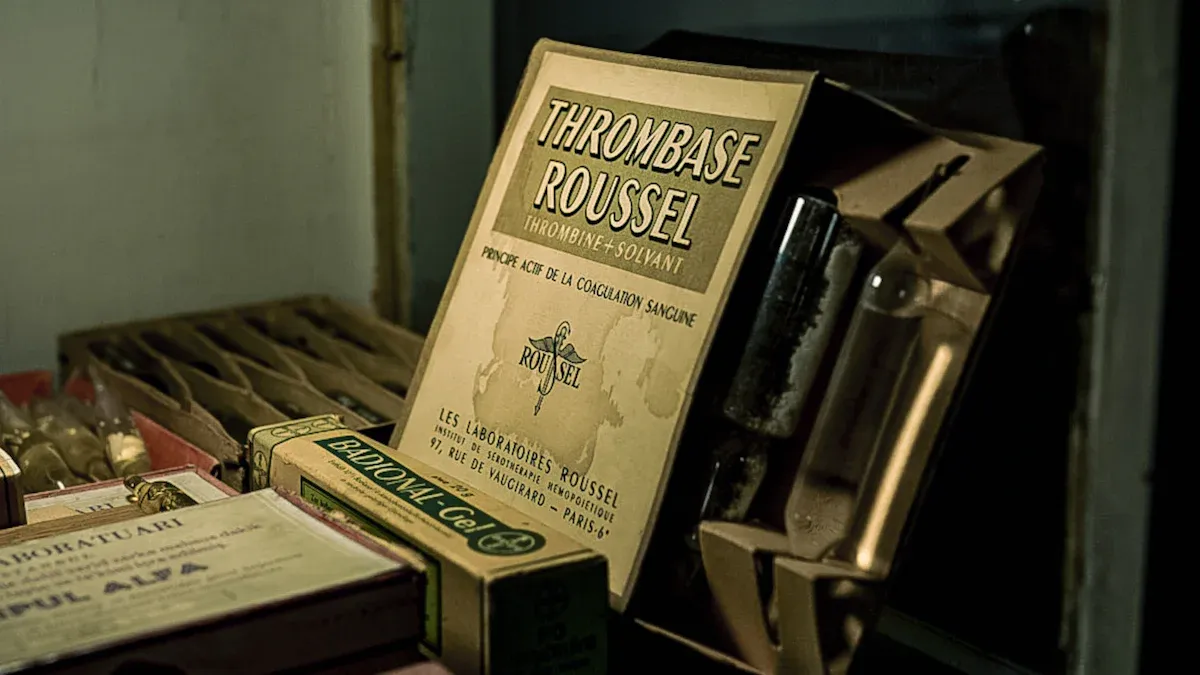How to Properly Store and Charge Your Flashlight Batteries

Proper storage of flashlight batteries plays a vital role in ensuring safety and extending their lifespan. You should always handle your helius flashlight batteries with care to maintain their performance. A well-maintained battery not only powers your flashlight effectively but also prevents potential hazards like leaks or overheating.
Key Takeaways
Keep flashlight batteries in a cool, dry spot. This stops leaks and rust, making them last longer and stay safe.
Use the right charger for your batteries every time. This avoids overcharging or overheating, which can harm the battery and shorten its life.
Check your batteries often for damage or wear. Finding problems early keeps them safe and helps your flashlight work well.
Why Proper Storage and Charging Matter
Risks of Improper Storage
Improper storage of batteries can lead to several safety hazards and performance issues. When you fail to store your batteries correctly, they may corrode and leak acid, which can damage your flashlight and pose health risks. Extended storage without proper care can also cause batteries to slowly discharge, reducing their lifespan and runtime. Corrosion from leaks may even affect the flashlight’s switches, leaving it inoperable when you need it most. In extreme cases, improper storage can increase the risk of fires due to short circuits or overheating.
Environmental factors like temperature and humidity also play a significant role in battery safety. High temperatures accelerate battery degradation, while high humidity can allow water to seep into the battery, potentially causing thermal runaway. To avoid these risks, always store your batteries in a cool, dry place and use a proper enclosure to protect them from environmental damage.
Consequences of Overcharging or Undercharging
Overcharging or undercharging batteries can severely impact their performance and lifespan. When you overcharge a battery, it may become excessively hot, as energy converts into heat instead of chemical energy. This can cause the battery case to swell or crack due to internal gas buildup. Over time, overcharging leads to electrolyte loss and structural damage, reducing the battery’s capacity and lifespan. In extreme cases, overcharging can even result in explosions, causing damage to your helius flashlight and surrounding components.
Undercharging, on the other hand, prevents the battery from reaching its full potential. Repeated undercharging can lead to incomplete chemical reactions, which reduce battery performance and cause it to discharge more quickly. To maintain optimal performance, always follow the best practices for charging and use a charger designed for your specific battery type.
Benefits of Proper Handling for Safety and Longevity
Proper storage and charging practices ensure your flashlight batteries remain safe and reliable. When you store your batteries in the right conditions, you minimize the risk of leaks, corrosion, and fire hazards. Proper charging habits also help maintain battery performance, allowing your flashlight to deliver consistent power when you need it.
By following these best practices, you can extend the lifespan of your batteries and reduce the need to dispose of them safely. This not only saves you money but also helps protect the environment. Regular maintenance and proper handling ensure your helius flashlight remains a dependable tool for years to come.
Best Practices for Storing Batteries

Ideal Temperature and Humidity Conditions
Storing batteries in the right environment is crucial for their longevity and safety. Always keep them in a cool and dry place to prevent damage. High temperatures can accelerate chemical reactions inside the battery, leading to leaks or reduced performance. Similarly, high humidity can cause moisture to seep into the battery, increasing the risk of corrosion or short circuits. For long-term storage, aim for a temperature range of 50°F to 77°F and maintain low humidity levels. Avoid placing batteries near heat sources, direct sunlight, or damp areas. Proper storage ensures your batteries remain functional and safe for extended periods.
Using a Dedicated Battery Storage Case
A dedicated storage case offers a secure way to store your batteries. It prevents physical damage and reduces the risk of short circuits. When choosing a case, consider the following features:
Size and Capacity: Ensure the case fits all your batteries with separate compartments for each type.
Material: Opt for fireproof or metal cases for added safety.
Compartments and Dividers: Individual compartments keep batteries from touching, minimizing short circuit risks.
Portability: Lightweight cases with handles or straps make transportation easier.
Safety Features: Look for locking mechanisms or child-proof designs to enhance safety.
Using a proper case not only protects your batteries but also keeps them organized and ready for use.
Safety Tips for Preventing Leaks or Damage
To prevent leaks or physical damage, follow these safety tips:
Regularly inspect batteries for signs of wear, corrosion, or leakage.
Store your batteries in a clean, cool and dry place, away from heat sources and sunlight.
Use safety goggles and gloves during maintenance to protect yourself.
Remove jewelry and electronics to avoid accidental short circuits.
Utilize insulated tools when handling batteries.
Ensure good ventilation in the storage area to prevent gas buildup.
By following these correct storage practices, you can extend the life of your batteries and reduce safety risks.
How to Charge Flashlight Batteries Safely

Choosing the Right Charger
Selecting the correct battery charger is essential for proper charging and the longevity of your flashlight batteries. Always ensure the charger is compatible with the size, shape, and voltage of your batteries. Using an incompatible charger can lead to inefficient charging or even damage. Look for chargers with appropriate voltage and current ratings to match your battery's specifications.
For added convenience, consider chargers with advanced features like LCD displays or cell balancing. These features provide better control and monitoring during the charging process. Safety should also be a priority. Choose chargers equipped with overcharge protection, short-circuit safeguards, and temperature monitoring. If you frequently travel, a compact and portable charger with USB ports can be a practical choice.
Monitoring Charging Duration
Paying attention to charging duration is one of the best practices to maintain battery health. Overcharging can cause overheating, which may damage the battery or reduce its lifespan. To avoid this, always follow the manufacturer's recommended charging times. Some modern chargers automatically stop charging once the battery is full, which helps prevent overcharging.
If your charger lacks this feature, set a timer or check the battery periodically. Avoid leaving batteries on the charger overnight or unattended for long periods. Proper charging techniques, such as monitoring the process, ensure your flashlight remains reliable and safe to use.
Precautions to Avoid Overcharging or Overheating
Taking precautions during charging can help you avoid overcharging or overheating your batteries. Always charge batteries in a well-ventilated area, away from flammable materials. Never leave charging batteries unattended, and check them periodically for excessive heat. Avoid using generic chargers that lack safety features, as they increase the risk of overcharging.
Follow the manufacturer's guidelines for charging times and voltage. Charging batteries in extreme temperatures can also lead to overheating or internal damage. Use the charger supplied with your flashlight whenever possible, and avoid charging rechargeable alkaline batteries while they are still inside the flashlight. These steps will help you avoid over-discharge and ensure safe and efficient charging.
Maintenance Tips for Longevity
Regular Inspections for Damage or Corrosion
You should regularly check battery condition to maintain rechargeable batteries and ensure their safety. Inspecting for damage or corrosion helps you identify potential issues before they worsen. Look for signs like bulging, leaks, or discoloration on your lithium-ion batteries. These indicate that the battery may no longer be safe to use.
To make inspections more effective, use tools designed for this purpose. The table below highlights some of the best tools and methods:
Tool/Method | Description |
|---|---|
Battery Tester | Provides a thorough view of the battery’s health, including charge/discharge rate. |
Battery Analyzers | Offers detailed information like internal resistance, indicating overall health. |
Thermal Camera | Detects heat to identify issues like short circuits or overcharging. |
Battery Management System | Monitors and manages battery performance, protecting it from damage. |
Using these tools ensures you can extend the lifespan of your rechargeable batteries and keep your flashlight reliable.
Cleaning Battery Contacts
Dirty or corroded battery contacts can reduce performance and shorten the lifespan of your lithium-ion batteries. Cleaning them regularly helps maintain rechargeable batteries and ensures optimal performance. Follow these best practices for cleaning:
Use vinegar or lemon juice to neutralize alkaline corrosion.
Scrub corroded parts with a toothbrush under water to remove residues.
Sandpaper or file away corrosion on the contacts.
Apply DeoxIT or similar products for protection after cleaning.
Safe cleaning materials include alcohol, vinegar, and lemon juice (ensure it’s sugar-free). After cleaning, apply dielectric grease to protect the contacts, though it may leave a slight residue. These steps help you maintain rechargeable batteries effectively.
Rotating Batteries to Ensure Even Usage
Rotating your lithium-ion batteries is a simple yet effective way to extend the lifespan of your rechargeable batteries. When you use the same battery repeatedly, it wears out faster than others. By rotating batteries, you distribute usage evenly, which helps maintain rechargeable batteries and prevents overuse of a single cell.
Label your batteries with numbers or dates to track their usage. Use them in sequence to ensure even wear. This practice is especially important for lithium-ion batteries, as consistent usage patterns help preserve their capacity. Regularly rotating batteries keeps your flashlight dependable and reduces the need for replacements.
Proper storage and charging practices are essential for maintaining the safety and performance of your helius flashlight. Always store batteries in a cool, dry place to prevent damage and extend battery life. Use the manufacturer’s recommended charger to avoid overcharging or undercharging, which can lead to diminished light output or physical damage. By following these habits, you not only ensure your flashlight remains reliable but also save money by reducing the need for frequent replacements.
💡 Tip: Regular maintenance and recognizing signs of battery failure, such as reduced performance, can further enhance the longevity of your helius flashlight.
FAQ
How often should you inspect your flashlight batteries?
Inspect your batteries every three months. Look for signs of corrosion, leaks, or damage to ensure they remain safe and functional.
Can you store batteries in the refrigerator?
No, storing batteries in the refrigerator can cause condensation, leading to corrosion or damage. Always store them in a cool, dry place instead.
What should you do if a battery leaks?
Wear gloves and clean the affected area with a mixture of baking soda and water. Dispose of the damaged battery following local hazardous waste guidelines.
See Also
Key Strategies for Proper Flashlight Care and Upkeep
Maximize Your Flashlight Battery Life With These Tips
Comprehensive Insights Into Flashlight Battery Usage And Care
Complete Handbook for Maintaining and Cleaning Your Flashlight
